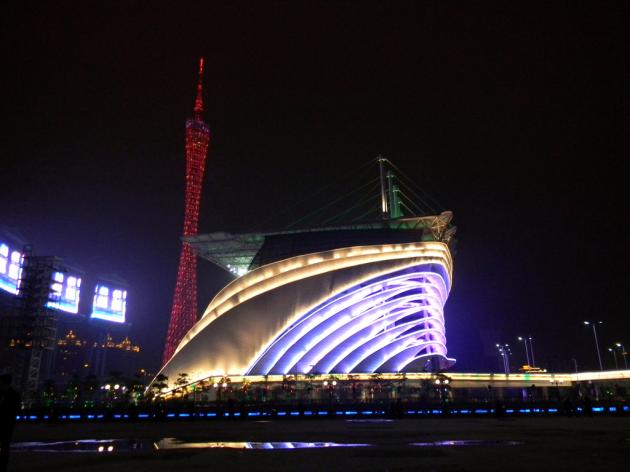Where old China meets its future

Guangzhou opens a gateway to the country's distant past and weird times to come
Thai passport holders are about to be offered a free ticket to ride China’s time machine.
Guangzhou has more than 2,200 years on the clock but now sits on the launch pad of the Middle Kingdom’s countdown to becoming the next world superpower.
Space-age buildings are surging onto the skyline, but tradition still maintains its foothold in this booming megacity of 13 million-plus people.
The good news for visitors is that Guangzhou is set to become the third Chinese city to grant a 72-hour visa waiver to transit passengers from 45 countries. They will find a two-millenia-old city that’s been the cultural and economic hub of South China since ancient times.
Its deepest roots are on display at the Museum Mausoleum of the Nanyue King, the oldest and largest Han Dynasty (206 BC-AD 220) tomb, whose funerary relics and elegant architecture are unmatched in China.
The remains entombed here are those of the second king of Nanyue, Zhao Mo (137-122 BC). Hidden 20 metres underground, the tomb is constructed of 750 huge stones with colourful murals and has more than 1,000 burial artefacts, highlighted by a garment made of 2,291 pieces of jade displayed on silk – the only one of its kind in the world.
Next to the museum is Yuexiu Park, the city’s largest, and famous for its picturesque scenes, Five-Ram Sculpture – symbol of the city – and Ming Dynasty (1368-1644) city wall.
It’s an ideal place for a relaxing walk on your journey through time.
You can also get a good view of the city from Zhenhai Tower, located in the park’s highest point. The five-storey tower, built in 1380, now houses the Guangzhou Museum and offers visitors insights into the city’s culture and history.
Just one metro stop away from Yuexiu Park is the Sun Yat-sen Memorial Hall, commemorating the founding father of modern China. In its tranquil and sombre surroundings, visitors can ponder the long and sometimes troubled road China has travelled since Sun began his uprising against the Qing here in 1895.
Shamian Island, near the Pearl River, is another pleasant spot for a stroll. It was an important port for the city’s foreign trade through the Song (960-1279) to the late Qing (1644-1911) dynasties.
The territory was divided into two concessions and given to France and the United Kingdom by the Qing government in the 19th century.
The island is now serves as a reminder of that colonial period, with quiet pedestrian avenues flanked by trees and lined with more than 100 historical buildings in various European styles.
A 10-minute drive away, Xiguan is another portal to colonial times. After feasting your eyes on its well-preserved traditional buildings, you can also chow down on the authentic Cantonese food the area is famous for, then check out the Lianxiang Teahouse’s afternoon performance of Cantonese opera – another local speciality.
Known for its colours, fragrance, taste and presentation, Cantonese
cuisine is an absolute must-try in Guangzhou. Local favourites include steamed shrimp dumplings, crispy durian pastries, steamed barbecued-pork buns and egg-custard tarts.
After sampling the charms of old Guangzhou in Xiguan, visitors can head to the riverside to soak in the city’s future.
The neon spike of Canton Tower rises gracefully from the banks of the Pearl River. Its peak carries the world’s highest Ferris wheel, offering a bird’s-eye view of the city.
Across the river is the giant “sailboat” – Haixinsha, the main venue of the 2010 Guangzhou Asian Games. Nearby is Guangzhou Opera House, a spaceship of a building designed by renowned Iraqi-British architect Zaha Hadid.
The Opera House juts into what, in just the past three years, has become the city’s cultural and business heart.
When you’re done with the opera house, you can wander through Guangdong Museum and Guangzhou New Library. Both buildings boast interesting architecture, with the former looking like a black jewellery box and the latter a white unfolded book.
If you prefer modern culture, make for Redtory, known as “Guangzhou’s 798 art zone”.
The buildings here have been transformed into art centres, restaurants and bars.
But for a trip into Guangzhou’s dazzling future, you’ll need to climb aboard a night cruise on the Pearl River. Neon visions on both banks compete for your attention, but it’s the Canton Tower, with its colourful “dress”, that wins most people’s gaze.
The best place to wrap up your whirlwind tour is probably in one of the three bar streets along the Pearl River – near Haizhu Plaza metro station, on Shamian Island, and the Party Pier Beer Culture and Art Zone. Here you can sit in the cool breeze, drinking beer, chatting with friends and soaking up the city’s nightscape.
Off the beaten track
Those not on the 72-hour visa-free transit tour have the luxury of leaving the provincial capital of Guangdong to explore other cities in the province.
Zhaoqing, a city two-hour drive from Guangzhou, boasts Ding-hu Mountain among its forests. Its abundance of wildlife have made it the first natural reserve in China to join Unesco’s Man and the Biosphere programme.
Birdsong and streams thread its deep and tranquil forests, offering balm for the traveller’s soul. Or, for nature with added adrenaline, head to the nearby Seven Stars Cave and join a rafting adventure.
RELATED





